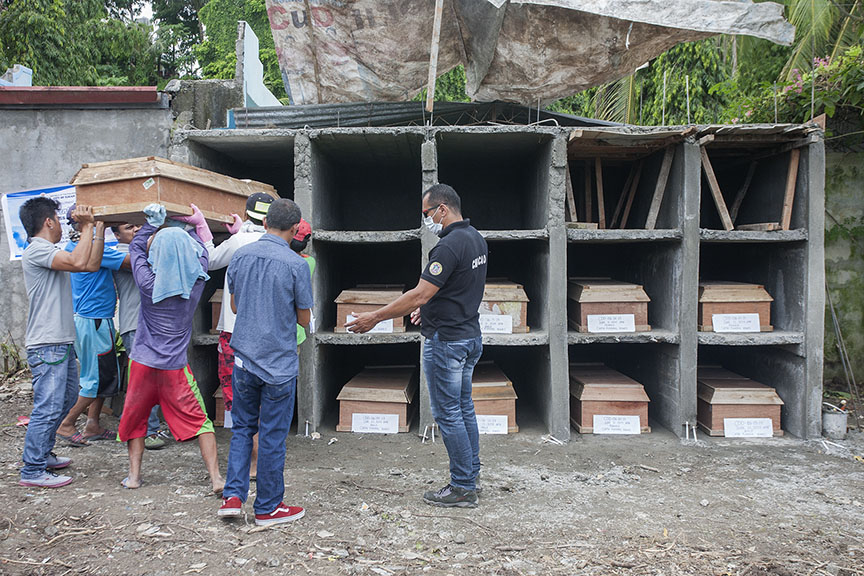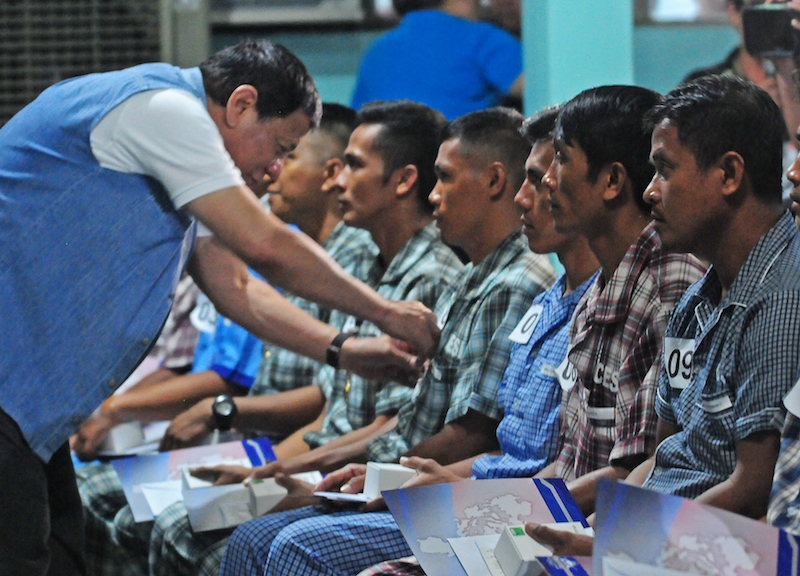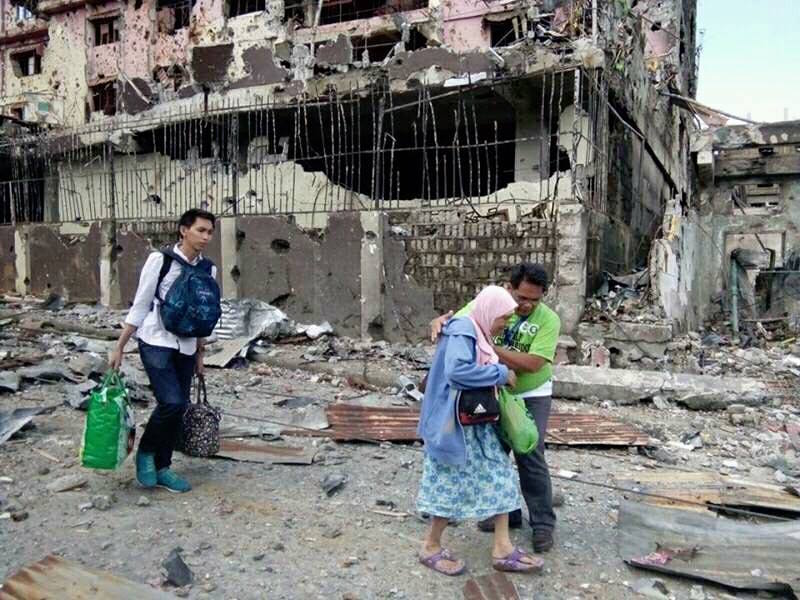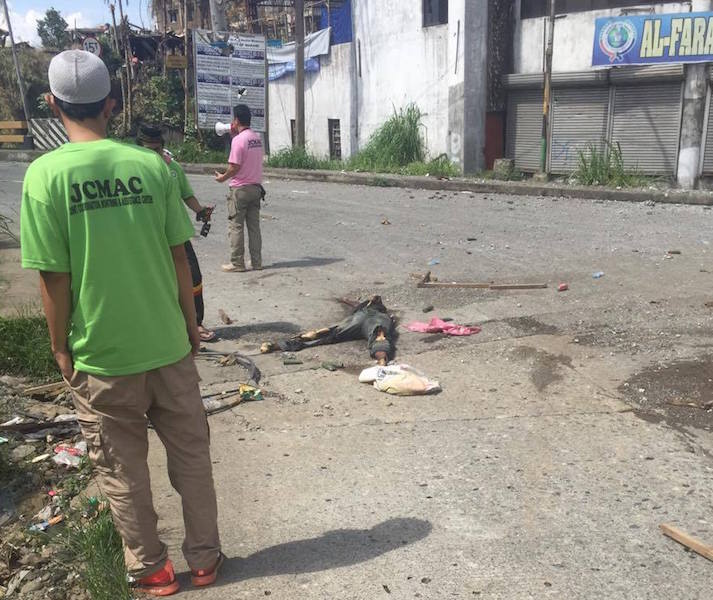The death toll in the month-long clashes between government forces and the Maute Group has risen to 384, at least 50 of them civilians. This, as the Marawi Crisis entered Day 30 on Wednesday, June 21,
At the Mindanao Hour press briefing in Malacanang on Wednesday, Presidential spokesperson Ernesto Abella said 268 terrorists, 66 government forces and 26 civilians had been killed, for a total of 360. Add to that 24 evacuees who died in hospitals, according to Health Secretary Paulyn Jean Ubial, and the grand total as of June 21 is 384.
Of 384, however, only 110 dead bodies have been accounted for: 66 government forces (63 soldiers, three police officers), the 24 evacuees who died in hospitals in Lanao del Sur and Lanao del Norte and 20 of the 26 civilians allegedly “killed by the terrorists” whose dead bodies were brought to the Capin Funeral Homes in Iligan City between May 27 and June 9.

Cemetery workers place the last of the 11 coffins containing the bodies of still unidentified victims in the Marawi City siege in their final resting place at the cemetery in Barangay Dalipuga, Iligan City. The interment was attended mainly by local government employees and the media. MindaNews photo by Bobby Timonera
Nine of the bodies had been claimed by relatives while the remaining 11 were buried at the San Roque Cemetery in Barangay Dalipuga also in Iligan on June 15, after they were processed (including taking of tissue samplings for DNA matching) and tagged by the Philippine National Police’s Scene of the Crime Operatives.
Wounded In Action; terrorists killed
The number of soldiers wounded in action is no longer mentioned during press briefings. But on June 14, Western Mindanao Command chief Lt. Gen. Carlito Galvez, in a statement denying reports they had ordered the bombing of mosques, said, “that’s the reason why I had more than 50 KIAs (killed in action) and 297 WIAs (wounded in action) because of our extremely restrictive rules of engagements. He said mosques are “no fire areas.”

President Rodrigo Duterte pins medals and gives away phones and Armscor Caliber .45 pistols to 79 more soldiers wounded in action (WIA) in the fight against the Maute Group in Marawi City at the Camp Evangelista Station Hospital on Tuesday June 20, 2017. Each soldier wounded in action also receives a P100,000 check and P10,000 cash. On June 11, Duterte also pinned medals on 84 WIA in Marawi in the same hospital. MindaNews photo by FROILAN O. GALLARDO
In the early days of the still ongoing war, the military spokespersons — Brig. Gen. Restituto Padilla in Manila and Lt. Col. Jo-Ar-Herrera in Marawi — would mention the number of terrorists killed, in two categories: “confirmed by body count” and “confirmed by eyewitness” accounts, e.g. 42 body count, the rest based on eyewitness accounts.
On the second week of the clashes, the military spokespersons stopped mentioning categories, just numbers.
The last “body count” of slain terrorists was on May 31, when the military reported 89 terrorists killed, 42 of them “confirmed by body count” and 47 “confirmed by eye witnesses.”
There is no way of confirming exactly how many terrorists have been killed since May 23. The 268 slain terrorists reported as of June 21, is a number claimed by the military.
Trapped / Hostaged
On June 9, as air strikes against the Maute Group in Marawi’s conflict zone intensified, the Provincial Crisis Management Committee (PCMC) spent Day 18 of the Marawi Crisis meeting with agencies to prepare for the retrieval of the dead in the conflict zone once the military declares these areas cleared.
Volunteer rescuers were also gathered to attend a crash course on retrieving dead bodies, conducted by the International Committee of the Red Cross and the Philippine Red Cross.
Lawyer Naguib Sinarimbo, PCMC Coordinator and member of the Secretariat, told MindaNews then that while conducting rescue operations to save lives remains the priority, “we are also conscious of the fact that the fighting has dragged on for a long time and as the day passes by, we have to contend with the reality that the chances of survival especially of those who have been injured decreases.”
Sinarimbo said there is a need to “calibrate our preparation as we may need to deploy for retrieval, which is why we are also training our rescue teams.”

No, this is not Aleppo. This is Marawi City, Sunday morning, 04 June 2017. A member of the Joint Coordinating, Monitoring, and Assistance Center of the GPH-MILF Peace Corridor assists an elderly woman leave the conflict zone, one of 134 trapped civilians rescued Sunday morning during a four-hour “humanitarian pause.” Photo courtesy of BANGSAMORO NEWS
PCMC spokesperson Zia Alonto Adiong told MindaNews on June 19 that they reckon “300 to 600” civilians remain trapped within the conflict zone. This is apart from the estimated 100 civilians held hostage by the Maute Group, including Fr. Teresito Soganub, Vicar General of the Prelature of Marawi.
Adiong expressed fears at least 100 dead bodies are in various stages of decomposition within the conflict zone, based on accounts of survivors and rescue volunteers.
Retrieval of dead bodies cannot be done unless the military declares the area cleared.
Preparing for the worst
A week earlier, on June 12, Adiong told a press briefing in Marawi: “I guess we need to ready ourselves for the worst once this (Baanggolo) bridge is opened,” as he noted that photographs shared online have given the public glimpses of the destruction in the conflict zone located in the city’s center, and accounts of rescuers who were able to enter the “hostile area” on June 4 as well as survivors indicate there are many dead bodies lying on the ground, some of them in an advanced stage of decomposition.
Adiong narrated that during the flag-raising ceremony on June 12, a police officer narrated that one of his friends received a text message that a trapped family in Barangay Raya Madaya had sent word their child has died of hunger and that they and their Christian employees have been eating their blanket for survival.
Other survivors narrated eating raw noodles until their supply ran out, some turned to eating leaves and many relied on rain for water.

The remains of a slain civilian along Gomisa Avenue leading to Banggolo district on June 4, 2017. awaits retrieval. Photo courtesy of Amerol Ariel
Samira Gutoc of the Ranao Rescue Team, told ABS-CBN News’ Headstart last Monday that residents trapped in the conflict zone for 28 days have been without access to food “in the areas of Marinaut, the coommercial area, the Banggolo plaza, Cabili — these are areas where people are eating we don’t know, God knows what they are eating. Some have reported blankets, they are eating from little drops of water from somewhere so its like I don’t know if it’s Africa I am looking at or yung movies na pinapanood natin.. it’s so real.”
She said some have resorted to eating boxes and leaves.
She explained is “double burden” for the Maranaos because of the ongoing Ramadan, the month-long fasting. “Some of them would observe fasting but at night when they can eat, there’s nothing to eat because there’s no commercial establishment (that is open). So we’re asking the Philippine Army, government and the Maute Group to let the food in, especially also in the evacuation centers in the first district of Lanao del Sur.
Gutoc contested the figure on slain civilians in the conflict zone. “We don’t agree that numbers are at just 20 as reported by media,” Gutoc said, adding that as early as Day 1, “one our volunteers saw a summary execution by the MG (Maute Group) guy.”
She said a volunteer whose nine-month old child died likely from suffocation when the city jail was burning on Day 1, May 23, reported seeing cadavers there.
“Every day, if you count three people die times 28 days,” that’s a huge number, Gutoc said, adding “we’re not talking three in recent days.”
Gutoc narrated how a son whose family was trapped in the conflict zone, dug up a shallow grave to bury his ailing father “who died in front of his eyes.”
Under normal circumstances, Maranaos bury their dead before sundown or within 24 hours, following rituals that include cleaning the corpse and wrapping it in white shroud.
Volunteer rescuers had earlier said some remains had been preyed upon by animals and maggots.
http://www.mindanews.com/top-stories/2017/06/counting-the-dead-in-marawi-of-384-at-least-50-civilian-deaths-confirmed/

No comments:
Post a Comment
Note: Only a member of this blog may post a comment.